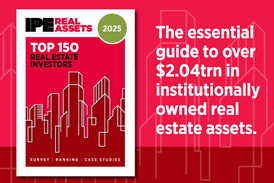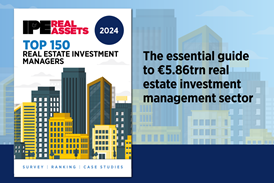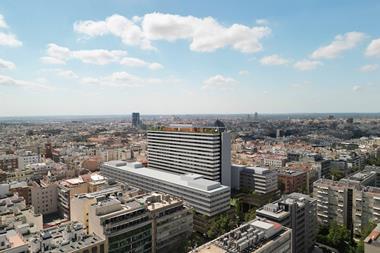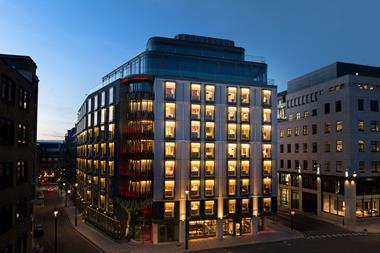The runaway popularity of the logistics sector requires a systematic approach to acquiring and managing assets, according to Cromwell’s country heads in France, Italy and the Nordics.
Cromwell Property Group, a real estate investor and manager with operations on three continents and a global investor base, knows a thing or two about property trends. The firm’s European management is supported by a multi-country team of investment, asset management and finance professionals, who have been charting the rise and rise of logistics and industrial real estate over the past decade as part of their commercial real estate strategy.
Today, logistics and industrial assets account for around a quarter of the portfolio of Cromwell’s funds under management in Europe, although there are interesting geographical differences. While the asset class dominates the firm’s French and German portfolios, it represents an increasingly important part of Cromwell’s Italian and Nordic business as well. Logistics Watch talks to Andrew Stacey, head of France, Pontus Flemme-Gardsell, head of Nordics, and Italy head Lorenzo Caroleo to find out more about territorial trends.
‘In France, investors are using the opportunity to sell off their poorer performing assets knowing that the market will pay premium values at the moment,’ observes Stacey. ‘Many first-time entrants to the market are potentially over estimating their underwriting in terms of rental growth and yield compression. A technically deficient asset, i.e. poor energy performance, low fire rating, will require substantial capital expenditure in order to attract future tenants at higher rental values than at present.’
Caroleo agrees that investor frenzy is adding pressure to the sector. ‘Italy is very similar to other countries in the sense that there is a lot of capital chasing any available opportunity. However, Italy remains cheap on a relative basis compared to other European countries, fundamentals remain strong, existing stock is dated, e-commerce penetration is low: the gap to bridge will remain so for the next 12 months at least.
‘In terms of new trends, we see capital moving outside most established locations and the lack of product has pushed many Core or Core+ investors into forward funding or forward purchase strategies. This is coupled with the logistics product becoming more institutional: in the past sellers were mostly private individuals, while now a first cycle is coming to a completion and product put on the market is sold by institutional players.’
For Flemme-Gardsell, market sentiment requires a creative approach. ‘The demand and interest in the logistics segment remains extremely high from investors across the whole risk/return spectrum.
‘As a result, prime logistics assets are trading at record levels and the trend is spreading to second tier locations. Since not all capital can compete for prime logistics, but still wants to take advantage of macro trends, creativity increases in the design of logistics products. Everything from simple relabelling of portfolios to products built around a narrow selection of locations and/or tenants.’
Adds Stacey: ‘We are also seeing pressure on developers trying to launch new schemes in greenfield areas. Planning has become even more difficult and complicated with a huge emphasis on the environmental impact a warehouse scheme will have on the flora and fauna. This impacts the amount of new stock coming to the market further increasing pricing due to the shortage of supply of Grade A investment product.’
Territorial differences
Key, pan-European logistics corridors play an important role in the evolution of territorial hotspots in each region. ‘Northern Italy has remained the flavour of the month for very long time, from west to east,’ confirms Caroleo. ‘The strong activity in good locations in Central Italy is not a surprise, however recently we have also seen institutional capital investing into logistics sector in South Italy or in locations that are far from being considered either “institutional” or “established”.
‘This confirms our view: thanks to Italy’s geographical configuration, the investable markets are more numerous than those usually covered by advisors’ market reports. This is also confirmed by our tenants that would be happy to move towards locations that are not an obvious choice.’
Notes Flemme-Gardsell: ‘We see activity throughout the entire Nordics although the geographical activity differs depending on subsector. For natural reasons, the activity of distribution centres has been skewed towards established logistics hubs, but we start seeing a rising activity in tail locations. In terms of last mile logistics, most of the activity is centered around large and growing consumer markets, i.e. top three cities in Sweden and top two cities in Denmark and top city in Finland.’
Adds Stacey: ‘Logistics activity in France is traditionally along the backbone of the country, ie north to south from Lille, Paris, Lyon to Marseille. The other key regions all experience periods of intense activity dependant upon the level of supply or large occupier demands in any given year. In general, around 40% of leasing activity happens in the Paris Ile de France Region every year. Despite Covid, the take up in France in 2020 was only slightly below the average take up over the past 10 years.’
For all three regional heads, the full range of asset types within the logistics sector are interesting when it comes to investment goals, including urban logistics, parcel depots and distribution centres.
Caroleo notes: ‘I have no strict preference for the sake of it. It all depends on micro-locations: catchment area and its demographics, number and sector of companies active in the area, transportation network, the presence of potential synergies. Local legislation, restrictions and barriers to entry also play a role in driving occupiers’ choice.’
Adds Flemme-Gardsell: ‘There is no one size fits all, but like many others, we like last mile logistics in close vicinity to the largest cities. All subsectors contribute to the distribution industry in their own way.’
Sourcing great product
Has the ‘wall of money’ in the sector made it harder to close deals? Caroleo suggests that his team has fine-tuned their approach. ‘Sourcing product is a never ending workstream, which involves the whole team and each of us is invited and incentivised to think outside the box. Local presence is key, especially in a very competitive market crowded by fast competitors.
‘We do our best to be perceived as very active in the market, making sure that we map every potential source of product and keep in contact with everyone in our far reaching network. It goes from personal to professional relationships, from advisor to lawyers, from brokers to tenants, from contractors to consultants.’
Adds Stacey: ‘There are numerous ways of sourcing product but the real key is having good market knowledge. Our teams are well established property professionals who over the years have built up their reputation, their network and are real specialists in their trade. It really is at heart a people business and all the automation in the world will never replace that. More specifically in France, a good lunch always helps as well!’
Notes Flemme-Gardsell: ‘Cromwell’s local footprint, local expertise and experience creates a competitive advantage in the search for the smaller assets and the ability to source and select these assets is key for finding good products. Compared to our peers, Cromwell benefits from having local offices (Malmö, Stockholm, Copenhagen and Helsinki) allowing us to have true local knowledge and close contacts with property owners as well as with the municipalities/cities.’
Adding value to logistics assets
Taking into consideration the sector’s ‘white hot’ popularity, asset management strategies remain key. Says Stacey: ‘The role of a good asset management team is always to add value. It’s fundamental to know your tenant, understand their business, work with them as well as the investor.
‘It’s a cliché but with experience built up over the years and knowing your product you can avoid expensive mistakes at day one by ensuring that the building you buy will be capable of maintaining the cashflow over the investment period and capital expenditure
kept to a minimum.’ For Flemme-Gardsell, ‘location is key’ in the value equation. He explains: ‘We don’t like to take risk on the location but in order to add value and generate returns we will consider assets of shorter lease structure, weak tenant covenants, poorer building quality, re-developments cases, new developments and speculative developments but always in strong micro locations.’
Adds Caroleo: ‘We have a clear track record of adding value across the whole risk/return spectrum and with different strategies. We have acquired several logistics warehouses from private sellers and created a single portfolio of institutional quality; we have taken a view on the micro-location and acquired assets at an entry yield now difficult to believe; we have acquired logistics assets with a short WALE and worked with the tenants to regear the leases; we are developing modern assets which will meet tenants’ demand as we know it today; finally we are continuously working with all stakeholders to make all assets in our portfolio ESG compliant as much as possible.’
ESG factors
All three regional heads agree that incorporating environmental, social and governance (ESG) aspects into an investment strategy is no longer optional. Says Stacey: ‘Warehousing is needed in our economies. Yes, they are large and have a big footprint but all of the major logistics developers are conscious of their obligations to build a product that meets the changing ESG requirements.
‘The last 15 years has seen massive advances in how warehouses are built and perform. They can be constructed with a whole host of features to minimise the running costs and impact on the environment. Wooden roof trusses, solar panels, air tight cladding, LED lighting, sensor switches, building management systems that control the heating/cooling, water retention systems, exterior landscaping wildlife sanctuaries etcetera. They also create employment, gone are the days of a warehouse being seen as a place to store boxes that never move.’
Suggests Flemme-Gardsell: ‘ESG must be viewed in a wider context. Logistics assets forms part of the distribution industry which is supported by a growing population that consumes more goods produced elsewhere in the world. This trend is not (currently at least) sustainable and all stakeholders within the supply chain need to take responsibility, this includes the manufacturer, transporter, the warehouse operator/ property owner and ultimately also the consumer.
‘Having said that, ESG is clearly an important investment criterion for us and as a property owner we can ensure the quality of our buildings and sometimes also put pressure on our clients.
‘We’ve seen a change including improvements over the last decade, everything from carbon neutral construction phases, energy optimisation, robot-controlled warehouse management and more efficient designs to name a few examples relating to the Environmental pillar within ESG. We expect this to accelerate over the coming decade and we feel optimistic that we can reach a near net zero supply chain with the support of new technology.’
Finally, Caroleo acknowledges that we don’t live in a perfect world, but that intent and effort go a long way. ‘The world is not “full green” or “net zero” yet, and this is particularly true for Italian logistics stock. We all know that we will go there. Repurposing of assets and brownfield remain a challenge, as often numbers do not stack up. Investors with different needs and different targets are active chasing different assets, and several assets have been exchanged as part of massive NPLs portfolios acquired by opportunistic investors. At the right entry point, those assets can have a new life.’



























